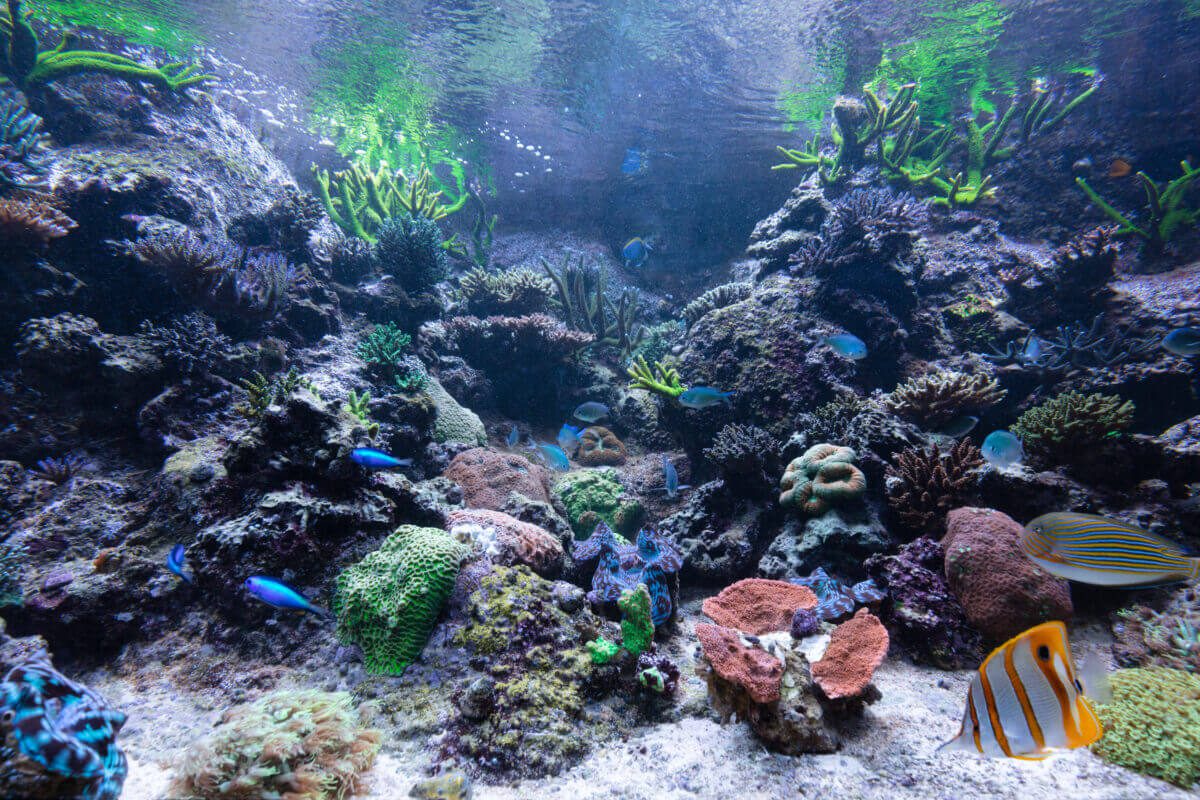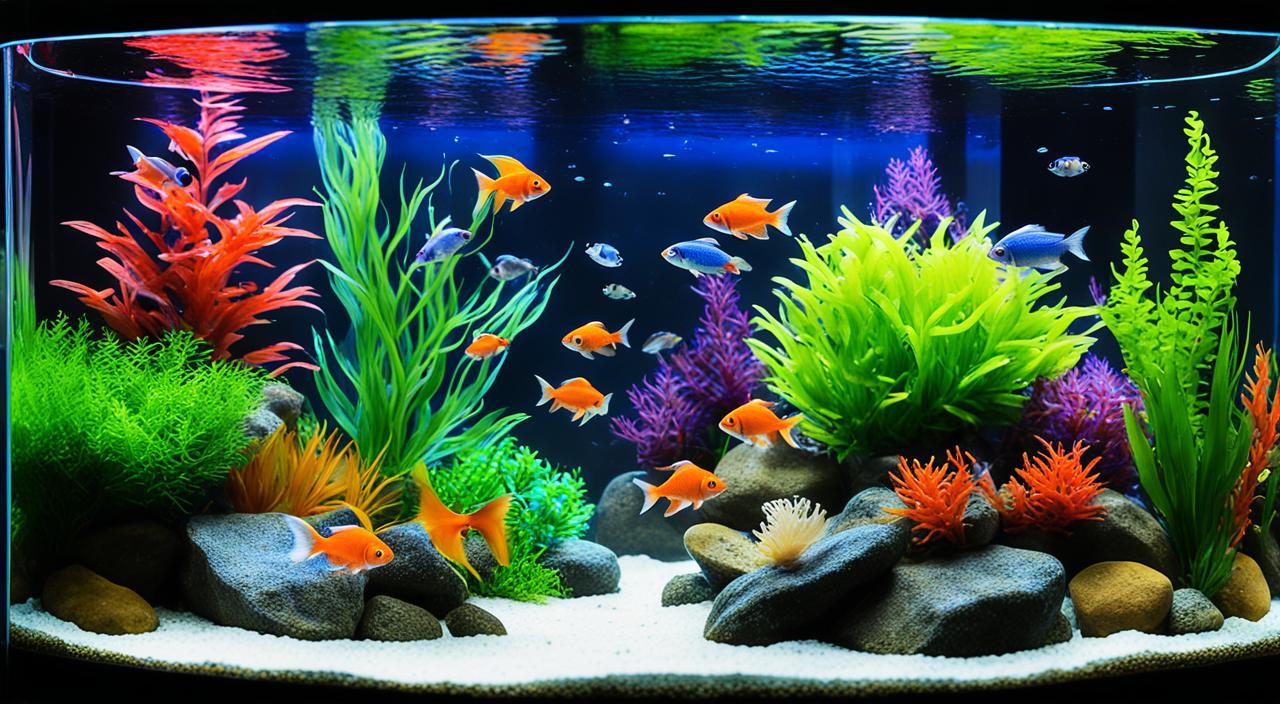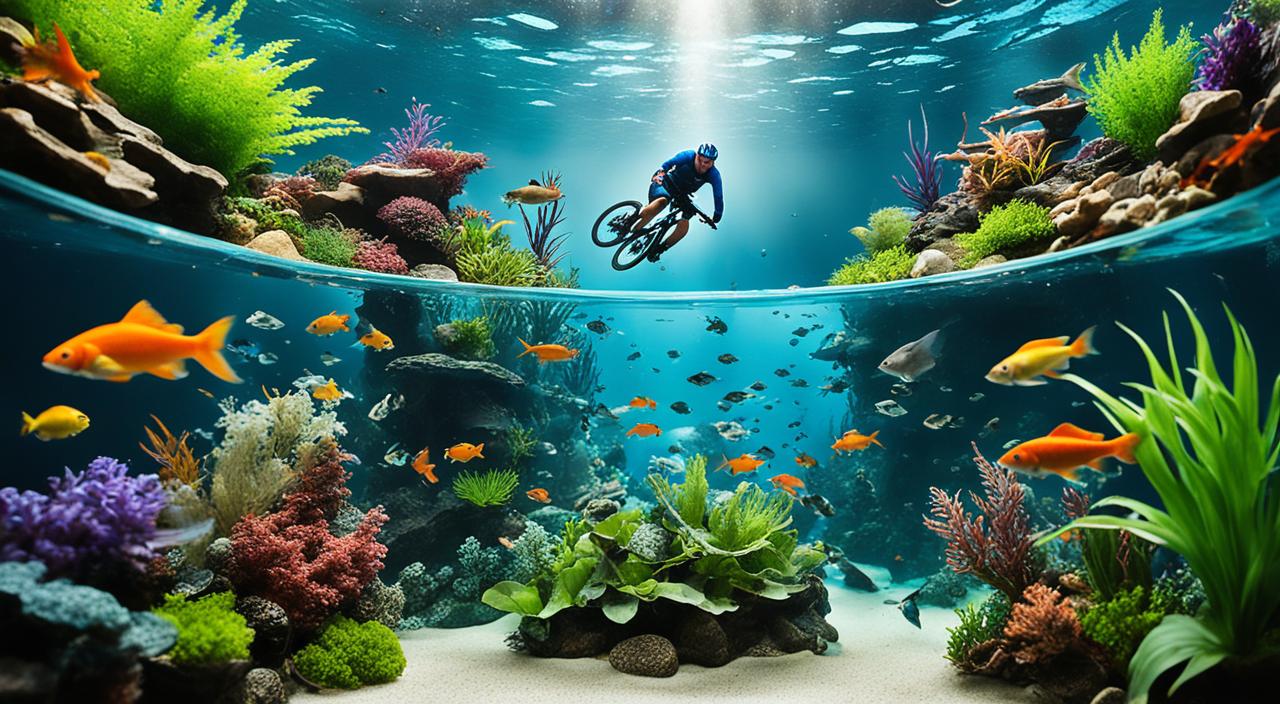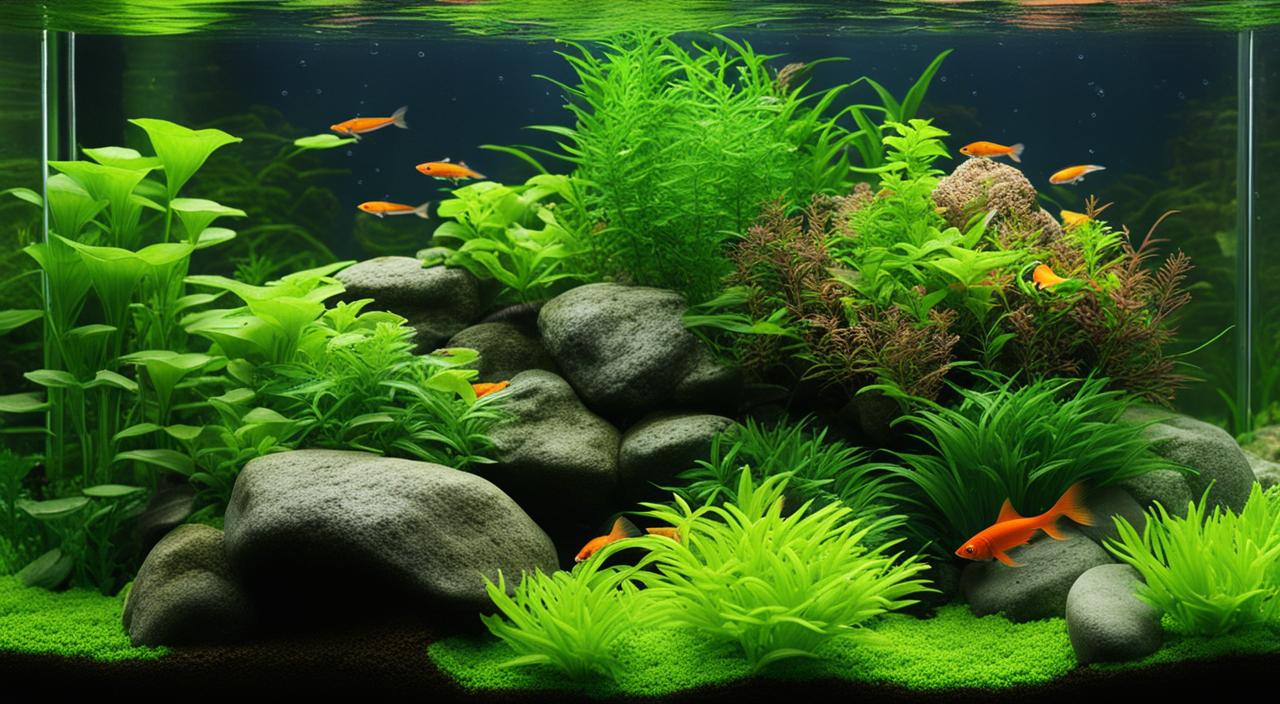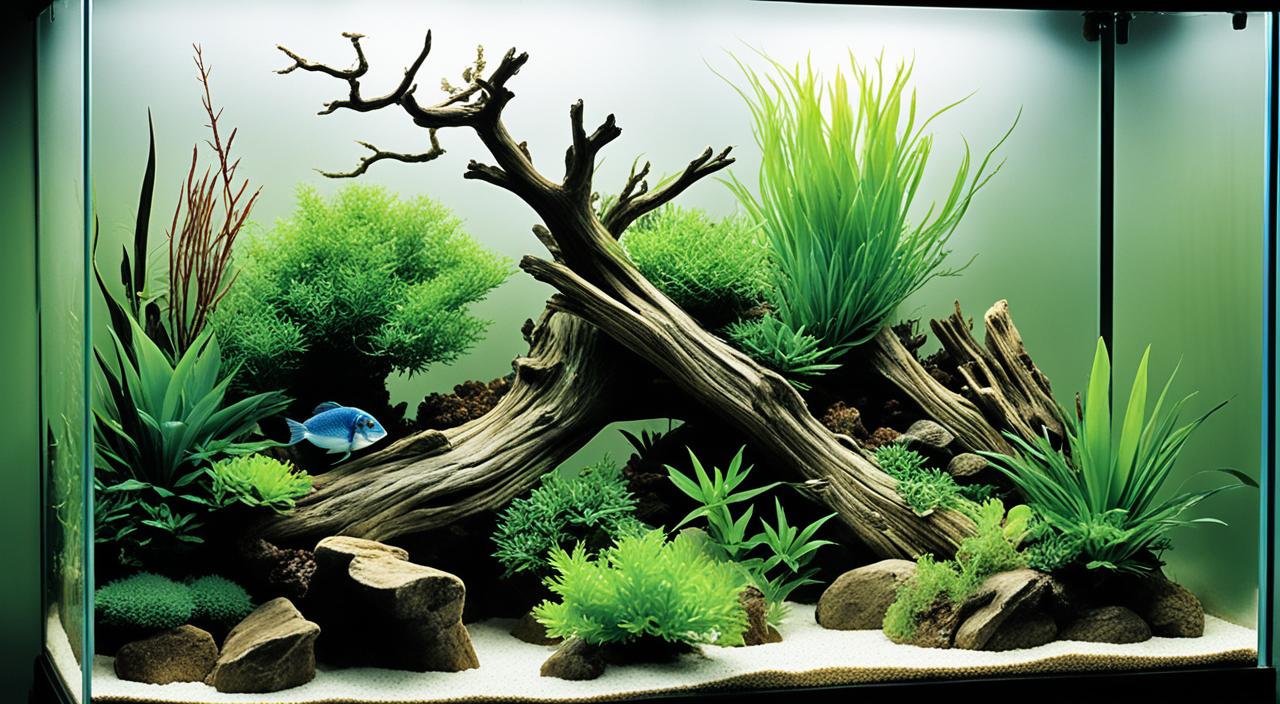Welcome to my beginner’s guide on mastering the basics of aquarium cycling. Whether you’re a new fish hobbyist or looking to refresh your knowledge, understanding the aquarium cycling process is crucial for creating a healthy and thriving aquatic environment. In this guide, I will walk you through the nitrogen cycle in aquariums, explain how to cycle an aquarium effectively and provide valuable tips to ensure a successful setup. Let’s dive in!
Key Takeaways:
- Understanding the nitrogen cycle is essential for maintaining a healthy aquarium environment.
- Cycling an aquarium involves establishing beneficial bacteria to convert toxic substances into less harmful forms.
- Proper preparations, equipment, and water treatment are crucial for successful aquarium cycling.
- Two primary methods for cycling an aquarium are fish and fishless.
- Regular testing, monitoring water parameters, and patience are critical factors for maintaining a well-cycled aquarium.
Understanding Aquarium Cycling and Its Importance
To maintain a healthy and thriving aquarium, it is crucial to understand the concept of aquarium cycling and its importance for fish health. Aquarium cycling is establishing and maintaining a balanced ecosystem within the aquarium, specifically related to the nitrogen cycle. This process is essential for creating a safe and stable environment for your fish.
What Aquarium Cycling Entails
Aquarium cycling involves the establishment of beneficial bacteria colonies in the aquarium. These bacteria are crucial in converting toxic chemicals like ammonia and nitrite into less harmful substances like nitrate. This process is known as the nitrogen cycle and is a natural biological process in all aquariums.
Why a Well-Cycled Aquarium Matters for Fish Health
A well-cycled aquarium is vital for your fish’s overall health and well-being. When an aquarium is not properly cycled, toxic chemicals like ammonia and nitrite can accumulate, posing significant risks to fish health. These toxins can cause stress, organ damage, and even death if not properly managed.
Establishing a well-cycled aquarium creates a stable and healthy environment for your fish, minimizing the risk of these harmful toxins. The beneficial bacteria in a well-cycled aquarium continuously work to remove and detoxify these chemicals, ensuring a safe and comfortable habitat for your fish.
Furthermore, a well-cycled aquarium promotes better water quality, improving fish health and vitality. It provides a stable ecosystem where fish can thrive, exhibit natural behaviours, and grow to their full potential.
Understanding the importance of aquarium cycling is crucial for any fishkeeper who wants to provide the best possible care for their fish. By creating a well-cycled aquarium, you are taking a proactive step towards ensuring your aquatic pets’ long-term health and happiness.
The Nitrogen Cycle in Aquariums Explained
To maintain a healthy and thriving aquarium, it is essential to understand the nitrogen cycle. The nitrogen cycle is a natural biological process in all aquariums and plays a vital role in creating a stable and safe environment for fish.
The Role of Beneficial Bacteria in Cycling
At the heart of the nitrogen cycle are beneficial bacteria. These bacteria, commonly known as nitrifying bacteria, convert harmful toxins, such as ammonia and nitrite, into a less harmful substance called nitrate. This process is crucial for the well-being of the fish, as high levels of ammonia and nitrite can be toxic and potentially fatal.
The beneficial bacteria colonize various surfaces within the aquarium, including the substrate, decorations, and biological filter. They thrive in areas with high oxygen levels and an ample ammonia supply. As the cycle progresses, the beneficial bacteria metabolize the ammonia, converting it into nitrite and then into nitrate.
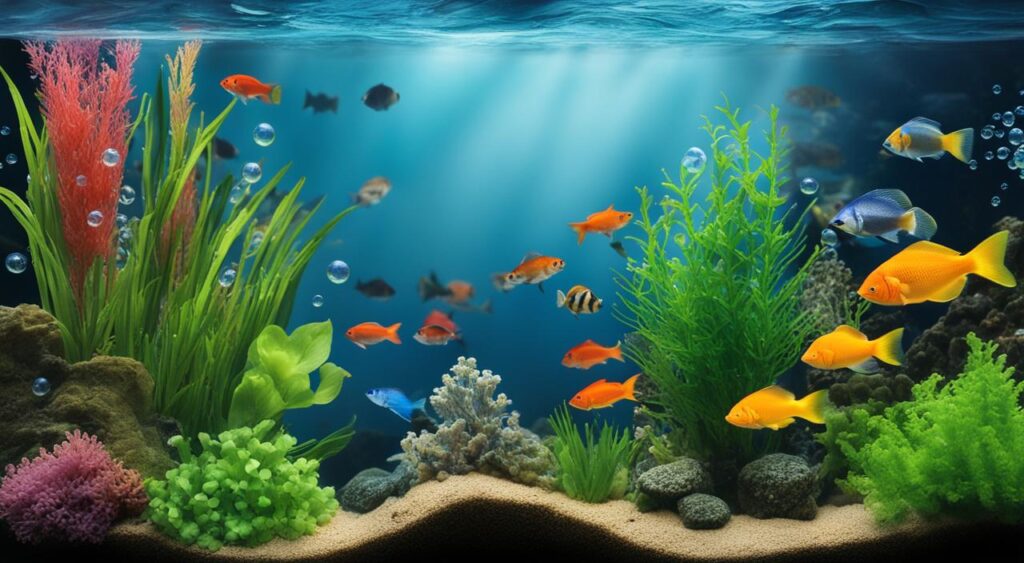
Transforming Harmful Toxins into Harmless Substances
During the nitrogen cycle, beneficial bacteria perform two essential transformations:
- Ammonia to Nitrite: Ammonia, primarily excreted by fish waste and decaying organic matter, is converted into nitrite by the bacteria. Nitrite is also toxic to fish but to a lesser extent than ammonia.
- Nitrite to Nitrate: Nitrite is then further transformed into nitrate by the bacteria. Nitrate is relatively harmless to fish in small quantities and is typically removed through the regular partial water changes performed in the aquarium.
By converting these harmful toxins into harmless substances, beneficial bacteria play a vital role in maintaining water quality and ensuring the overall health of the aquarium inhabitants.
| Toxins | Harmful Effects | Beneficial Bacteria Transformation | Harmless Substance |
|---|---|---|---|
| Ammonia | Harmful to fish and can cause stress, illness, and death. | Bacteria convert ammonia to nitrite. | Nitrite |
| Nitrite | It is harmful to fish and can cause stress, illness, and death. | Bacteria convert nitrite to nitrate. | Nitrate |
It is important to note that although nitrate is less toxic than ammonia and nitrite, high nitrate levels can still negatively impact fish health. Regular water changes are necessary to keep nitrate levels within a safe range for the aquarium inhabitants.
Understanding the nitrogen cycle and the role of beneficial bacteria is critical to creating a healthy and balanced aquarium ecosystem. By ensuring the presence of these bacteria and monitoring water parameters, aquarists can maintain a stable and thriving environment for their fish.
Preparations Before Starting Your Aquarium Cycle
Before beginning the aquarium cycling process, it is essential to make specific preparations. The success of your aquarium cycle and the health of your fish depend on these initial steps. This section will provide a detailed guide on the preparations required before starting your aquarium cycle.
Setting Up the Fish Tank
When setting up your fish tank, there are a few key factors to consider. Firstly, choose an appropriate location for your aquarium, ensuring it is away from direct sunlight and extreme temperature fluctuations. Next, thoroughly clean the tank with warm water, avoiding using soap or chemicals that may harm your fish. Rinse all decorations, substrate, and equipment placed in the aquarium to remove dust or debris. Once your tank is clean and dry, it is ready to be filled.
Acquiring the Necessary Equipment
Having the right equipment is crucial for a successful aquarium cycle. Here are some essential items you will need:
- Aquarium Filter: Choose a filter that is suitable for the size of your tank. It will help remove waste and toxins from the water.
- Heater: Depending on the type of fish you plan to keep, you may need a heater to maintain the proper temperature in your tank.
- Air Pump: An air pump helps oxygenate the water, providing a healthier environment for your fish.
- Substrate: Choose a substrate appropriate for your fish species and provides a natural and comfortable environment.
- Decorations: Add decorations, such as rocks, plants, and caves, to create hiding places and stimulate a natural habitat for your fish.
Treating the Water
Before adding water to your aquarium, treating it to ensure its suitability for the cycling process is crucial. You can use a water conditioner to remove harmful chemicals from tap water, such as chlorine and chloramine. Additionally, it is advisable to test the water for pH, ammonia, nitrite, and nitrate levels using appropriate test kits. This will help you monitor the water parameters and ensure a healthy environment for your fish.
Following these preparations, you will be well-equipped to start your aquarium cycle and create a thriving ecosystem for your fish.
| Preparations Before Starting Your Aquarium Cycle |
|---|
| 1. Set up the fish tank in an appropriate location away from direct sunlight and extreme temperature changes. |
| 2. Thoroughly clean the tank, decorations, substrate, and equipment before adding water. |
| 3. Acquire essential equipment such as an aquarium filter, heater, air pump, substrate, and decorations. |
| 4. Treat the water with a water conditioner to remove harmful chemicals and test the water parameters. |
Basics of Aquarium Cycling: The Foundational Knowledge
To cycle an aquarium successfully, it is essential to have a solid foundation of knowledge. This section will cover the essential elements and equipment for practical aquarium cycling. Additionally, I will guide you on establishing beneficial bacteria colonies in the biological filter, a crucial aspect of the cycling process.
Equipment Needed for Effective Cycling
The right equipment is essential for creating a suitable environment for beneficial bacteria to thrive and facilitating the cycling process. Here are some key pieces of cycling equipment:
- Aquarium filter: A biological filter is crucial for establishing beneficial bacteria colonies. Choose a filter that provides ample surface area for bacteria growth and has a suitable flow rate for your tank size.
- Heater: Maintaining a consistent temperature is essential for the growth and activity of beneficial bacteria. Invest in a heater that can effectively regulate the water temperature in your aquarium.
- Air pump and airstone: Adequate oxygenation is necessary to support the growth of beneficial bacteria. An air pump and airstone help ensure proper oxygen circulation in the tank.
- Decorations and substrate: Adding decorations, such as rocks, plants, and driftwood, provides surface area for bacteria colonization while creating a visually appealing environment for your fish.
Acquiring and properly utilizing these essential equipment creates an ideal foundation for a successful cycling process.
Establishing Beneficial Bacteria Colonies
A critical step in the aquarium cycling is establishing beneficial bacteria colonies in the biological filter. These bacteria play a vital role in the nitrogen cycle, converting harmful ammonia into less toxic substances.
To establish beneficial bacteria colonies:
- Start with an established filter or biological media: If possible, use an established filter or biological media from a mature aquarium to introduce the beneficial bacteria into your tank.
- Seed the biological filter: Place the established filter or biological media in your aquarium’s filter. Alternatively, you can add a bacterial supplement designed to introduce beneficial bacteria.
- Provide an ammonia source: Introduce a source of ammonia, such as fish food or pure ammonia, to feed the beneficial bacteria and kick-start the cycling process. This will simulate the waste produced by fish and provide a food source for the bacteria.
- Monitor water parameters: Regularly test the water parameters, particularly the levels of ammonia, nitrite, and nitrate, to ensure the cycling process is progressing correctly.
- Be patient: Establishing beneficial bacteria colonies can take several weeks. Patience is critical, allowing the bacteria to establish and grow.
These steps will lay a solid foundation for a healthy and adequately cycled aquarium.
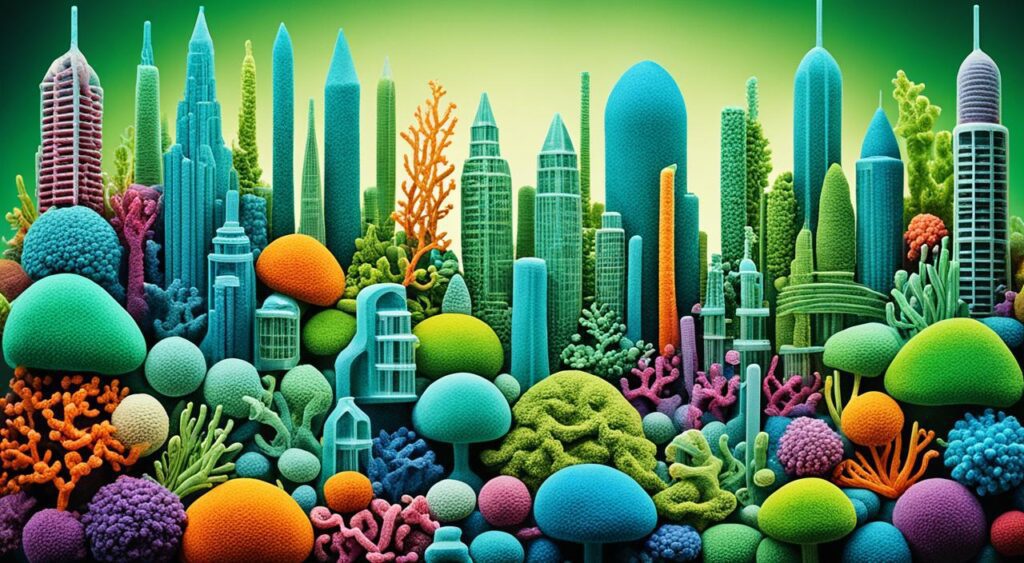
Cycling with Fish: A Step-by-Step Guide
For those who prefer to cycle their aquarium with fish, I will provide a detailed step-by-step guide to ensure a successful cycling process. Follow these instructions to keep your fish safe and healthy while establishing a stable aquarium environment.
To begin, choose hardy fish species that can tolerate the fluctuations in water parameters during the cycling process. Some popular options include Zebra Danios, White Cloud Mountain Minnows, and Platies. Introduce a small group of these fish to kickstart the cycling process.
Feeding the fish thriftily is essential during cycling. Overfeeding can lead to an increase in ammonia levels, prolonging the cycling process and harming the fish. Offer small amounts of food that the fish can consume within a few minutes, and remove any uneaten food promptly.
Regularly monitoring the ammonia levels is crucial to ensure the well-being of your fish. Use an aquarium test kit to measure ammonia levels, aiming for an initial reading of around 2-4 ppm. As the cycling progresses, monitor the levels and observe them gradually decreasing. The cycling process is complete once the ammonia and nitrite levels reach 0 ppm.
In addition to monitoring ammonia levels, regular partial water changes are necessary to maintain a healthy environment for the fish. Test the water parameters before each water change to ensure proper levels. Replace approximately 25% of the water with conditioned freshwater to dilute accumulated toxins and promote a stable aquarium environment.
Following this step-by-step guide, you can successfully cycle your aquarium while keeping your fish safe and healthy.
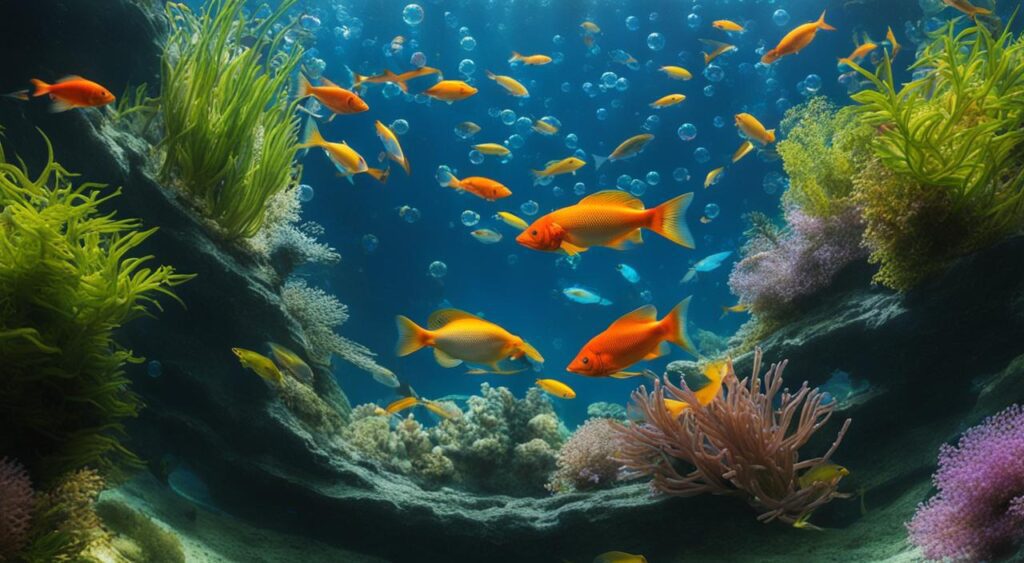
Fishless Cycling Aquarium: An Ethical Method
When it comes to cycling an aquarium, an alternative method is gaining popularity among ethical aquarists: fishless cycling. This approach allows you to establish beneficial bacteria colonies without subjecting fish to potentially harmful conditions. By choosing fishless cycling, you can ensure the well-being of fish while still achieving an adequately cycled aquarium.
Setting Up a Fishless Cycle
To set up a fishless cycle, you’ll need an alternative source of ammonia. The most common method is liquid ammonia or ammonium chloride, found in aquarium supply stores. The goal is to provide a small, controlled amount of ammonia in the aquarium to kickstart the growth of beneficial bacteria.
Here’s a step-by-step guide to setting up a fishless cycle:
- Prepare your aquarium by setting up the necessary equipment, such as a filter, heater, and substrate.
- Add an ammonia source, following the instructions on the product you choose. Start with a small amount of ammonia, around 2-4 ppm (parts per million).
- Monitor the ammonia levels regularly using a test kit. Ideally, the levels should drop to zero within 24-48 hours.
- As the beneficial bacteria colonies develop, they convert the ammonia into nitrite. Monitor the nitrite levels using a test kit.
- Continue adding ammonia as needed to maintain a low but detectable level. This will ensure the beneficial bacteria have a constant food source to thrive.
- Eventually, the nitrite levels will also begin to decrease, indicating the presence of beneficial bacteria that convert nitrite into nitrate.
- Monitor the nitrate levels and perform water changes to keep them within a safe range.
Monitoring Ammonia Levels Without Fish
Without fish in the aquarium, it’s crucial to closely monitor the ammonia levels to ensure they remain within a safe range for the beneficial bacteria. Regular testing using an ammonia test kit will allow you to track the progress of the cycling process and make adjustments as necessary.
In addition to testing, observing the visual indicators of a well-progressed fishless cycle is essential. These include the absence of cloudy water and the presence of healthy-looking biofilm on surfaces within the aquarium. A matured fishless cycle will exhibit stable ammonia and nitrite levels, with a consistent drop to zero within 24 hours.
By adopting the fishless cycling method, you can create a safe and healthy environment for fish while still achieving a fully cycled aquarium. This ethical approach allows you to establish beneficial bacteria colonies without subjecting fish to potentially harmful conditions. With careful monitoring, patience, and dedication, you can complete the fishless cycling process and prepare your aquarium for its future inhabitants.
Cycling a New Tank: The Two Popular Methods
When it comes to cycling a new tank, aquarists commonly use two popular methods: with-fish cycling and fishless cycling. Each method has its pros and cons, and choosing the right method for your tank depends on various factors. In this section, we will explore the advantages and disadvantages of these two methods and provide guidance on deciding which method best suits your preferences and circumstances.
Pros and Cons of With-Fish vs. Fishless Cycling
With-Fish Cycling:
- Pros:
- It immediately allows fish to be introduced, making the process more exciting and enjoyable.
- It helps establish a diverse microbial community in the tank.
- Cons:
- Potentially exposes fish to high levels of ammonia and nitrite, which can harm their health.
- Requires careful monitoring of water parameters and frequent water changes to ensure fish safety.
- It may take longer to cycle the tank due to the need for gradual ammonia buildup.
Fishless Cycling:
- Pros:
- Eliminates the risk of harming fish during the cycling process.
- Allows for precise control of ammonia levels, ensuring a safer and more efficient cycling process.
- Potentially faster cycling time compared to with-fish cycling.
- Cons:
- It is less exciting than with-fish cycling, as no fish are present.
- Requires the addition of a pure ammonia source or other alternative methods to introduce ammonia into the tank.
- Maintaining ammonia levels within the desired range may require additional monitoring and adjustments.
How to Decide Which Method to Use
Choosing the proper method for cycling your new tank largely depends on your personal preferences, the species of fish you plan to keep, and your experience level. Consider the following factors to help you make an informed decision:
- The sensitivity of the fish species you intend to keep: Fishless cycling is generally considered safer if you keep delicate or sensitive fish species.
- Time constraints: If you want to start enjoying your new tank with fish immediately, with-fish cycling may be more suitable, but be prepared for the extra time and effort required to ensure fish health and safety.
- Personal preference: Some aquarists enjoy observing the cycling process with fish, while others prefer the convenience and control of fishless cycling.
Ultimately, the choice between with-fish and fishless cycling comes down to balancing the benefits and drawbacks of each method and aligning them with your specific needs and circumstances.
Aquarium Cycling Tips for a Successful Setup
When it comes to setting up your aquarium for a successful cycling process, it’s important to pay attention to key factors such as water parameters, testing, patience, and troubleshooting. These tips will help you navigate the aquarium cycling journey and ensure a smooth experience for both you and your fish.
1. Monitor Water Parameters: Regularly test the water for parameters such as ammonia, nitrite, and nitrate levels. Keeping these parameters in check will ensure a healthy environment for your fish and promote the growth of beneficial bacteria.
2. Regular Testing: Test your water regularly using a reliable test kit. This will not only help you keep track of the progress of your aquarium cycling but also alert you to any potential issues that may arise.
3. Maintain Patience: Patience is key during the aquarium cycling process. It takes time for beneficial bacteria to establish and for the nitrogen cycle to stabilize. Resist the temptation to add fish too soon and allow your aquarium to fully cycle before introducing any livestock.
4. Troubleshooting Common Issues: Be prepared to troubleshoot common problems that may arise during the cycling process, such as cloudy water, excessive algae growth, or sudden ammonia spikes. Research and implement appropriate solutions to maintain a healthy and stable aquarium environment.
How to Speed Up the Aquarium Cycling Process
For aquarists who are eager to expedite the aquarium cycling process, there are several strategies you can employ to achieve faster results. By utilizing cheat cycling hacks responsibly, you can quicken the cycle without compromising the health and well-being of your fish. Additionally, it is essential to understand the timeline of aquarium cycling to set realistic expectations and track the progress of your tank’s cycle.
Cheat Cycling Hacks: Quickening the Process Responsibly
One cheat cycling hack to speed up the process is to introduce filter cartridges and pads from an established tank. These contain beneficial bacteria that aid in the breakdown of toxins, accelerating the cycling process. By transferring these established filtration materials to your new tank, you jumpstart the colonization of beneficial bacteria, reducing the time it takes for your tank to cycle.
Another cheat cycling hack is to add live plants to your aquarium. Live plants not only enhance the aesthetics of your tank but also contribute to the growth of beneficial bacteria. The plants absorb nutrients, including ammonia and nitrate, providing a natural source for the nitrogen cycle to occur. This promotes the establishment of a healthy biological filter, expediting the cycling process.
It’s important to note that while cheat cycling hacks can speed up the cycling process, they should be used responsibly. Always monitor water parameters and ensure that your tank’s ecosystem remains stable. Avoid relying solely on cheat cycling methods and continue performing regular maintenance tasks, such as water testing and partial water changes, to promote a healthy and balanced environment.
Understanding the Timeline of Cycling Your Tank
The aquarium cycling process follows a timeline that consists of several stages. Understanding this timeline can help you estimate the duration of each stage and manage your expectations. Generally, the timeline for aquarium cycling can range from a few weeks to a few months, depending on factors such as tank size, filtration efficiency, and the cycling method used.
The initial stage of the cycle involves the accumulation of ammonia, a byproduct of fish waste and decaying organic matter. During this stage, beneficial bacteria colonize and convert ammonia into nitrite. Nitrite is also toxic to fish, but as the cycle progresses, another group of beneficial bacteria develop and convert nitrite into nitrate, which is less harmful.
Once the cycle is established, ammonia and nitrite levels will decrease, and nitrate will accumulate. This indicates that the cycling process is nearing completion. Regular water testing is crucial during this stage to ensure that ammonia and nitrite levels remain at safe levels for fish. A fully cycled tank will have undetectable ammonia and nitrite levels, with only nitrates present.
It’s important to note that the timeline of aquarium cycling is not set in stone and can vary from tank to tank. Factors such as water quality, temperature, and fish bio-load can influence each stage’s duration. Patience and diligence are key during this process, as rushing or skipping stages can lead to imbalances and harm the health of your fish.
Beyond the Cycle: Maintaining Aquarium Health
Now that you have successfully cycled your aquarium, it’s essential to understand that the work doesn’t end there. Regular testing and water changes are crucial to ensure the long-term health and well-being of your fish. By maintaining optimal water parameters, you create an environment that supports the growth and vitality of your aquatic inhabitants.
Regular Testing and Water Changes Post-Cycle
Once your aquarium has completed the cycling process, it’s recommended to continue testing the water regularly. Monitoring parameters such as ammonia, nitrite, nitrate, pH, and temperature is essential to detect any changes or imbalances that may occur over time. By identifying issues early on, you can take corrective measures to prevent any harm to your fish.
In addition to regular testing, performing routine water changes is vital for maintaining water quality. These water changes help remove accumulated toxins and waste products, replenish essential minerals and nutrients, and ensure a stable and healthy environment for your fish. Aim to perform a partial water change of about 10-20% every one to two weeks, depending on the needs of your specific aquarium.
The Perpetual Nature of the Nitrogen Cycle
It’s important to remember that the nitrogen cycle is a continuous process in your aquarium. Even after the initial cycling phase, beneficial bacteria will continue to break down ammonia and nitrite into less harmful nitrate. This ongoing cycle is essential for maintaining water quality and preventing the accumulation of toxins that can be detrimental to fish health.
Regular testing and water changes play a crucial role in supporting the perpetual nature of the nitrogen cycle. By frequently monitoring water parameters and taking proactive measures, you ensure that beneficial bacteria continue to thrive and stabilise your aquarium environment. This ongoing care will contribute to your aquatic inhabitants’ continued health and well-being.
In conclusion, maintaining aquarium health goes beyond the cycling process. Regular testing and water changes are essential post-cycle activities to ensure optimal water quality. By embracing the perpetual nature of the nitrogen cycle and providing the necessary care, you create an environment that promotes your fish’s long-term health and thriving.
FAQ
What is aquarium cycling?
Aquarium cycling is the process of establishing a stable and balanced ecosystem in a fish tank. It involves the growth of beneficial bacteria that convert toxic chemicals, such as ammonia and nitrite, into less harmful substances like nitrate.
Why is aquarium cycling important?
Aquarium cycling is crucial for the health and well-being of fish. It helps maintain proper water parameters and prevents the build-up of toxic chemicals that can harm fish. A well-cycled aquarium provides a safe and stable environment for fish to thrive.
How does the nitrogen cycle work in aquariums?
The nitrogen cycle is a biological process that occurs in aquariums. It involves the conversion of ammonia into nitrite by beneficial bacteria, and then the conversion of nitrite into nitrate by different strains of bacteria. Nitrate is less harmful to fish and can be removed through regular water changes.
What preparations should be made before starting the aquarium cycle?
Before starting the aquarium cycle, it’s important to set up the fish tank, acquire necessary equipment such as filters and heaters, and treat the water to remove chlorine and other harmful substances. Proper preparations ensure a suitable environment for the cycling process to occur.
What equipment is needed for effective aquarium cycling?
To cycle an aquarium effectively, you will need a filter, heater, air pump, and decorations. These items help establish and maintain beneficial bacteria colonies in the biological filter, which are essential for the cycling process.
How do I cycle an aquarium with fish?
To cycle an aquarium with fish, start by introducing hardy fish that can tolerate the cycling process. Monitor ammonia levels, feed the fish sparingly, and regularly change a portion of the water to control ammonia and nitrite levels. This method requires close attention to ensure the fish’s well-being during the cycle.
What is fishless cycling and how do I set it up?
Fishless cycling is an ethical alternative to cycling with fish. It involves adding a source of ammonia, such as pure ammonia or fish food, to the aquarium to simulate the production of ammonia by fish. By monitoring ammonia levels and adding ammonia as needed, beneficial bacteria will establish and grow without subjecting fish to toxic conditions.
What are the pros and cons of with-fish cycling vs. fishless cycling?
With-fish cycling allows for immediate fish tank stocking but can subject fish to stressful conditions. Fishless cycling is more ethical and reduces the risk of harming fish, although it takes longer to complete the cycle. The choice depends on individual preferences and considerations of animal welfare.
What are some aquarium cycling tips for a successful set-up?
Some tips for a successful aquarium cycling set-up include regularly testing water parameters, maintaining patience during the process, and troubleshooting common issues like ammonia spikes. Monitoring and adjusting water conditions as needed will help ensure a healthy cycling environment for the fish.
How can I speed up the aquarium cycling process?
To speed up the aquarium cycling process, you can use cheat cycling hacks responsibly. Examples include using filter cartridges and pads from an established tank, adding live plants to promote the growth of beneficial bacteria, and ensuring optimal water conditions. However, it’s important to monitor water parameters closely to avoid potential problems.
What steps should I take to maintain aquarium health beyond the cycle?
To maintain aquarium health after the cycle, regular testing of water parameters, such as ammonia, nitrite, nitrate, and pH, is essential. Water changes to remove excess nitrate and other pollutants should be performed regularly. Understanding the ongoing nature of the nitrogen cycle and providing proper care is crucial for a healthy and thriving aquarium.

